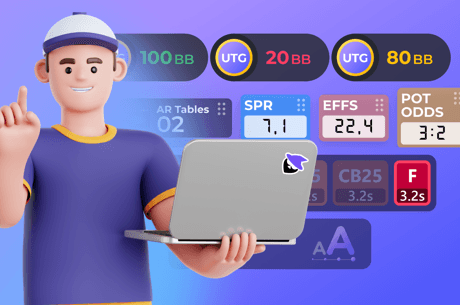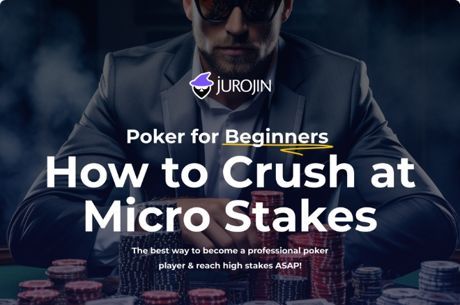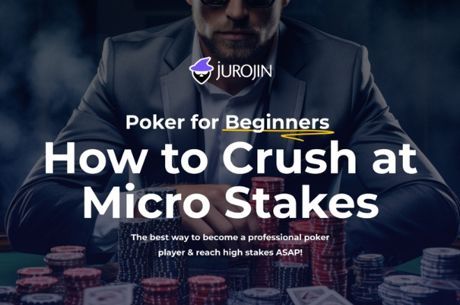When Checking Back Goes Wrong

Typically after having been the initial raiser and flopping a medium-strength hand with position, many players will check back to control the size of the pot. Of course, if we always have medium-strength hands when we check back in these spots, opponents will figure that out and thus play against us accordingly going forward.
Therefore it sometimes makes sense also to check back very strong hands — that is, ones that do not benefit much from protection, such as A-A on an A-2-2 flop. Doing this guards us against those times our opponent later tries to blast us off our range with big turn and river bets.
That said, checking back strong hands can sometimes lead to tricky decisions later. Let’s look at an example from a real hand played recently online that illustrates an example of just such a circumstance.
Checking Back the Flop, Calling on the Turn
In a 100NL ($0.50/$1) game played online, a regular opened under the gun to $3 and another regular defended the big blind with a call. The effective stacks were 100 big blinds. The flop came A♣Q♦2♣ and the action went check-check.
How often does the under-the-gun player want to check back this flop? When he has pocket kings, pocket jacks, queen-ten suited? A few medium-strength hands? What else?
Most of the time, the player will be looking to bet aces, semi-bluffs and bluffs, and strong value hands. So it may seem that he is telegraphing the strength of his range by checking this flop, which was all too easy to continuation bet.
The 7♥ fell on the turn, an apparent brick as only A-7 and 7-7 would improve. The big blind seemed to be thinking exactly that, as he fired out a pot-sized bet of almost $8. The initial raiser was not taken off his hand so easily, however, and he called.
Forcing the Issue
The river card was the J♠, making the final board A♣Q♦2♣7♥J♠, and the big blind decided to hammer away again with a pot-sized bet, this time to $27.
The bigger the bet size, the more bluffs a player can have, if that player is betting a balanced range.
With a pot-sized bet, the big blind (if balanced) is saying he will be bluffing at least once for every two value bets he has. The initial raiser can call one pot-sized bet to win two, so when he calls with a bluff-catcher he will break even.
That J♠ river, however, completes one of the more obvious turn bluffs — K-T — and pairs turn other bluffs K-J and J-T. Some J-x club draws have also paired up.
If the big blind is canny, he should know that J-T cannot beat the set of hands the UTG player is representing when he calls the turn. After all, J-x still loses to Q-x and K-K. But in practice, many players do not recognize that, or do not want to bluff with a pair in general.
Surprise, Surprise
Things finally get interesting when the initial raiser responds to the big blind's big river bet by moving all in. He seems to be effectively representing J-J that stubbornly called the turn, or A-A that was waiting in the weeds the entire time. His best bluffs here are T-T (that was also stubborn on the turn) or K-K, since these hands block K-T in the big blind’s possible range.
It makes sense for the initial raiser to balance his A-A and J-J value bets with T-T and other bluffs, but does it make sense to be raising here at all? It's an interesting question, because under the gun might not open any K-T combinations (or only the four suited ones), while the big blind can defend all 16 combinations of K-T.
Similarly, the initial raiser might continuation bet all four of his K-T suited combinations, meaning he can’t have them after he checks back the flop. In other words, the big blind is more uncapped on this runout given the sequence of postflop actions. This makes raising the river dangerous for even A-A — it will run into K-T quite a lot if called — even though he is winning very often when he flat-calls the river bet.
I am sure many reading will find the idea of just flatting A-A facing this action too conservative — fair enough. But the logic behind that example will lead me to the hand with which the initial raiser actually moved all in — A♠Q♥ (top two pair).
Now, if A-A is a profitable river call, surely the same is true of A-Q. In spots such as this it is important to stick with a plan. The initial raiser checked back A-Q ostensibly because it was hard for the big blind to have connected with the flop and to catch bluffs. Meanwhile he can catch bluffs on the river with it by calling.
In order for this raise-shove to be profitable, he needs to be called by all A-J combinations, all A-7 suited combos, and all A-2 suited combos, then somehow avoid the three combinations each of 2-2 and 7-7 and the 16 of K-T.
In other words, UTG is value betting a range thinner than the one that beats him.
The Deck Deals Lessons
This occasion was a learning opportunity for the UTG player. He got all the action he wanted after he checked the flop. But then he went for glory on the river, thinking “I have underrepresented my hand.”
When your opponent pots the river, typically he does not have medium-strength hands that are going to reward a value-raise with a loose call. He either has something very strong or a bluff. On this board, A-Q sits between these two hands. Therefore, just calling the river was the play to make.
But instead he shoved, and when his opponent called he lost his full stack to 7♣7♠ (a turned set of sevens).










